

[1203.0161] Self-Charged Graphene Battery Harvests Electricity from Thermal Energy of the Environment. Solar Nanopaint - Paint With Quantum Dot Solar Cells. Solar cells have been in the mainstream news for quite a while, almost since the initial discovery of the photovoltaic effect by French physicist A.
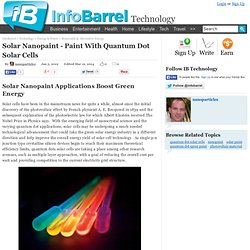
E. Becquerel in 1839 and the subsequent explanation of the photoelectric law for which Albert Einstein received The Nobel Prize in Physics 1921. With the emerging field of nanocrystal science and the varying quantum dot applications, solar cells may be undergoing a much needed technological advancement that could take the green solar energy industry in a different direction and help improve the overall energy yield of solar cell technology. As single p-n junction type crystalline silicon devices begin to reach their maximum theoretical efficiency limits, quantum dots solar cells are taking a place among other research avenues, such as multiple layer approaches, with a goal of reducing the overall cost per watt and providing competition to the current electricity grid structure.
Credit: by argonne on Flickr. Vanadium oxide microactuators: These are the nanobots you’re looking for. Nanotechnology has promised us a fantastic world where miniature factories could build devices atom by atom.
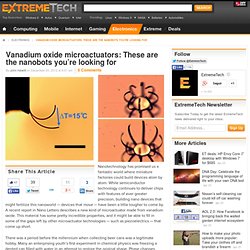
While semiconductor technology continues to deliver chips with features of ever greater precision, building nano devices that might fertilize this nanoworld — devices that move — have been a little tougher to come by. A recent report in Nano Letters describes a new kind of microactuator made from vanadium oxide.
This material has some pretty incredible properties, and it might be able to fill in some of the gaps left by other microactuator technologies — such as piezoelectrics — that come up short. MIT discovers a new state of matter, a new kind of magnetism. Researchers at MIT have discovered a new state of matter with a new kind of magnetism.
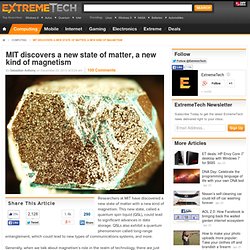
This new state, called a quantum spin liquid (QSL), could lead to significant advances in data storage. QSLs also exhibit a quantum phenomenon called long-range entanglement, which could lead to new types of communications systems, and more. Generally, when we talk about magnetism’s role in the realm of technology, there are just two types: Ferromagnetism and antiferromagnetism. Ferromagnetism has been known about for centuries, and is the underlying force behind your compass’s spinning needle or the permanent bar magnets you played with at school.
In ferromagnets, the spin (i.e. charge) of every electron is aligned in the same direction, causing two distinct poles. In the case of quantum spin liquids, the material is a solid crystal — but the internal magnetic state is constantly in flux. Engineers weld nanowires with light. At the nano level, researchers at Stanford have discovered a new way to weld together meshes of tiny wires.
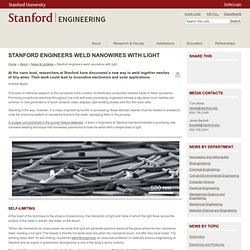
Their work could lead to innovative electronics and solar applications. First synthesis of gold nanoparticles inside human hair for dyeing and much more. Public release date: 5-Dec-2012 [ Print | E-mail Share ] [ Close Window ] Contact: Michael Bernsteinm_bernstein@acs.org 202-872-6042American Chemical Society In a discovery with applications ranging from hair dyeing to electronic sensors to development of materials with improved properties, scientists are reporting the first synthesis of gold nanoparticles inside human hairs.
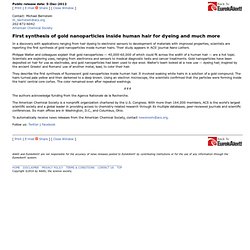
Their study appears in ACS' journal Nano Letters. Engineers create polymer light-emitting devices that can be stretched like rubber. Stretchable electronics, an emerging class of modern electronic materials that can bend and stretch, have the potential to be used in a wide range of applications, including wearable electronics, "smart skins" and minimally invasive biomedical devices that can move with the body.

Today's conventional inorganic electronic devices are brittle, and while they have a certain flexibility achieved using ultrathin layers of inorganic materials, these devices are either flexible, meaning they can be bent, or they are stretchable, containing a discrete LED chip interconnected with stretchable electrodes. But they lack "intrinsic stretchabilty," in which every part of the device is stretchable. Now, researchers at the UCLA Henry Samueli School of Engineering and Applied Science have demonstrated for the first time an intrinsically stretchable polymer light-emitting device.
Cheap Solar Power at Night Solar power has two main problems: it’s expensive, and it’s intermittent, since the output of a solar power plant depends on the time of day and cloud cover.
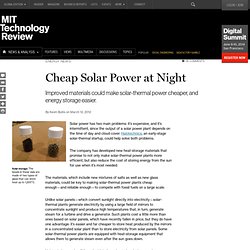
Halotechnics, an early-stage solar-thermal startup, could help solve both problems. The company has developed new heat-storage materials that promise to not only make solar-thermal power plants more efficient, but also reduce the cost of storing energy from the sun for use when it’s most needed. The materials, which include new mixtures of salts as well as new glass materials, could be key to making solar-thermal power plants cheap enough—and reliable enough—to compete with fossil fuels on a large scale. 3-D Printer with Nano-Precision. Printing three-dimensional objects with incredibly fine details is now possible using "two-photon lithography.

" With this technology, tiny structures on a nanometer scale can be fabricated. Researchers at the Vienna University of Technology (TU Vienna) have now made a major breakthrough in speeding up this printing technique: The high-precision-3D-printer at TU Vienna is orders of magnitude faster than similar devices. Nanotrees harvest the sun's energy to turn water into hydrogen fuel. University of California, San Diego electrical engineers are building a forest of tiny nanowire trees in order to cleanly capture solar energy without using fossil fuels and harvest it for hydrogen fuel generation.

Reporting in the journal Nanoscale, the team said nanowires, which are made from abundant natural materials like silicon and zinc oxide, also offer a cheap way to deliver hydrogen fuel on a mass scale. "This is a clean way to generate clean fuel," said Deli Wang, professor in the Department of Electrical and Computer Engineering at the UC San Diego Jacobs School of Engineering. The trees' vertical structure and branches are keys to capturing the maximum amount of solar energy, according to Wang.
That's because the vertical structure of trees grabs and adsorbs light while flat surfaces simply reflect it, Wang said, adding that it is also similar to retinal photoreceptor cells in the human eye. The vertical branch structure also maximizes hydrogen gas output, said Sun. Nanowires enable faster, low-power 10nm 3D transistors. Faster organic semiconductors for flexible displays can be developed quickly with new method. 'Dark plasmons' transmit energy. Microscopic channels of gold nanoparticles have the ability to transmit electromagnetic energy that starts as light and propagates via "dark plasmons," according to researchers at Rice University.
A new paper in the American Chemical Society journal Nano Letters shows how even disordered collections of nanoparticles in arrays as thin as 150 nanometers can be turned into waveguides and transmit signals an order of magnitude better than previous experiments were able to achieve. Efficient energy transfer on the micrometer scale may greatly improve optoelectronic devices. The Rice lab of Stephan Link, an assistant professor of chemistry and electrical and computer engineering, has developed a way to "print" fine lines of gold nanoparticles on glass.
These lines of nanoparticles can transmit a signal from one nanoparticle to the next over many microns, much farther than previous attempts and roughly equivalent to results seen using gold nanowires. Lightning-fast, efficient data transmission developed at Stanford. The First Anti-Laser: The Reverse Mohawk of the Photon World. Last summer, a team of scientists at Yale dreamed up blueprints for the world’s first anti-laser (a device that absorbs amplified light rather than emitting amplified light).
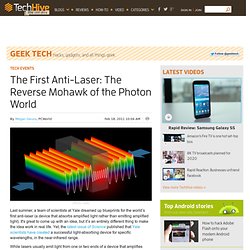
It's great to come up with an idea, but it’s an entirely different thing to make the idea work in real life. Yet, the latest issue of Science published that Yale scientists have created a successful light-absorbing device for specific wavelengths, in the near-infrared range. New kind of high-temperature photonic crystal could someday power everything from smartphones to spacecraft. A team of MIT researchers has developed a way of making a high-temperature version of a kind of materials called photonic crystals, using metals such as tungsten or tantalum. The new materials — which can operate at temperatures up to 1200 degrees Celsius — could find a wide variety of applications powering portable electronic devices, spacecraft to probe deep space, and new infrared light emitters that could be used as chemical detectors and sensors.
Compared to earlier attempts to make high-temperature photonic crystals, the new approach is “higher performance, simpler, robust and amenable to inexpensive large-scale production,” says Ivan Celanovic ScD ’06, senior author of a paper describing the work in the Proceedings of the National Academy of Sciences. The paper was co-authored by MIT professors John Joannopoulos and Marin Soljačić, graduate students Yi Xiang Yeng and Walker Chen, affiliate Michael Ghebrebrhan and former postdoc Peter Bermel.
Atoms to X-Rays: Sensing with Nanomaterials. Sandia, UK partners publish groundbreaking work on Criegee intermediates in Science magazine. Public release date: 13-Jan-2012 [ Print | E-mail Share ] [ Close Window ] Monitoring the transformation of silver nanowires into gold nanotubes with in situ transmission X-ray microscopy. Berkeley creates flexible, rugged, plastic electronic skin with carbon nanotubes. Using semiconductor-enriched carbon nanotubes, researchers from the Department of Energy’s Berkeley Lab have pioneered a technique for creating large-scale, flexible, inexpensive, thin-film transistor “electronic skin.”
These stretchy, rugged sheets are the first step in creating wearable computers, intelligent sensors that can treat infections, and computers/books that can be folded up into a jacket pocket. A carbon nanotube, like graphene, is flexible and strong, and thus an ideal candidate for flexible transistors — but naturally forms into two forms, one of which is metallic, the other a semiconductor. This mixture can be used to make thin-film transistors, but its not as conductive, and thus not as useful. To make the electronic skin, the Berkeley researchers had to purify a solution of carbon nanotubes so that 99% were the semiconductor form. Self-healing circuits fix themselves after damage. New Hydrogel for Better, Scar-Free Wound Healing. New Solar Cell Gives Its "110 Percent" in Efficiency. Like Tebow, these new solar cells are giving their "110 percent" week in and week out.
Solar Panels Are Cheaper Than We've Been Told. Paint-on solar cells developed. How 3-D Photovoltaics Could Revolutionize Solar Power The Sun sends some 87 Petawatts of power our way and converting some small fraction of this into usable power is one of the key battlefronts in the fight to free the world from its addiction to oil. One way to do this conversion is to turn light into electricity using flat photovoltaic panels. This form of power generation is rapidly expanding all over the world. Flexible Solar Cells Reach Record Efficiency of 18.7% Photo: Empa The Previous Record was 17.6% German scientists build world's smallest steam engine using lasers. A 50-year quest to isolate the thermoelectric effect is now over: Magnon drag unveiled. Struttin’ its stuff. Monty Python may claim credit for immortalizing the “silly walk,” but molecular biology beat the comedy troupe to the punch. It turns out that a tiny motor inside of us called dynein, one tasked with shuttling vital payloads throughout the cell’s intricate highway infrastructure, staggers like a drunken sailor, quite contrary to the regular, efficient poise of its fellow motors.
Further Evidence That Photosynthesis Involves Quantum Mechanics. Nano Paint Could Make Airplanes Invisible to Radar. First inkjet-printed graphene computer circuit is transparent, flexible. Cornell scientists review future of graphene. Giant flakes make graphene oxide gel. Graphene electronics moves into a third dimension. Graphene electronics moves into a third dimension. Graphene acts as plasmonic antenna, leads towards 0.1nm wires in chips. Scientists harnessing photosynthesis to produce fuel cells via artificial leaf. World's first ultra-thin, low energy molybdenite microchip tested. New method of growing high-quality graphene promising for next-gen technology. Graphene transistors compatible with living cells.
Researchers enhance graphene to enable multicolor photodetection. Graphene supermaterial goes superpermeable: Can be used to distill alcohol. Graphene: The perfect water filter. Graphene creates electricity when struck by light. Frustration inspires new form of graphene. Graphene Competitor Used to Make Circuits. Graphene may exhibit exotic superconductivity. Multiferroics could lead to low-power devices. A Super-Absorbent Solar Material. NASA creates groundbreaking super black light absorbing material. MIT researchers are printing solar cells on sheets of paper – Computer Chips & Hardware Technology. 3M film turns windows into transparent solar panels. A Brighter Way to Make Solar Cells. Scientists see the solar future, and it's all about 'nanodomes' and 'plasmonics' Down to the wire: Inexpensive technique for making high quality nanowire solar cells developed. Born to be Viral: Watch a surgical robot peel a grape. Nanoparticle electrode for batteries could make grid-scale power storage feasible.
Superconductor May Hide Long-sought Secret. Team develops highly efficient method for creating flexible, transparent electrodes. New "Ultra-Battery" as Energy-Dense as High Explosives. Light created from a vacuum: Casimir effect observed in superconducting circuit. MIT creates diode for light, makes photonic silicon chips possible. Two Diamonds Linked by Strange Quantum Entanglement. Entangled diamonds vibrate together. First quantum jiggles detected in solid object - physics-math - 28 January 2012. Converting light to sound in cold quantum systems. Quantum qubits found in cheap, mass-produced semiconductor.
In new quantum-dot LED design, researchers turn troublesome molecules to their advantage. NYU scientists' creation of self-replication process holds promise for production of new materials. Practical Invisibility Cloaks. Current-steering nanomaterial could lead to self-rewiring electronics. NIST polishes method for creating tiny diamond machines. Edible carbon dioxide sponge: All-natural nanostructures could address pressing environmental problem. Nanoparticle assembly is like building with LEGOs. Paradigm Shift in Understanding of Biology Could Alter Electronics. Scientists make magic auto-origami using ink and light (video) Training Bacteria To Grow Consumer Goods. New contact lens to display images in front of wearer's eyes. Scientists Use Carbon Nanotubes to Create an Underwater Invisibility Cloak. Scientists have used carbon nanotubes to engineer the most powerful artificial muscles ever.
Nanotube Cables Hit a Milestone: As Good as Copper. Carbon Nanotubes Used to Stitch Materials Together. Smallest-Ever Nanotube Transistors Outperform Silicon. Nanotube growth theory experimentally confirmed. Wearable Electronics Could Transform Therapies. Flexible nanowire electronics that can attach to any material developed at Stanford.
Scientists grow nanowire directly on a crystal — and help usher in the next generation of electronics. Engineers weld nanowires with light. Research reveals shocking new way to create nanoporous materials. Tiny Tubes Could Absorb More Carbon Dioxide Than Trees - Environment. Experiments demonstrate nanoscale metallic conductivity in ferroelectrics. Perfect nanotubes shine brightest: Researchers show how length, imperfections affect carbon nanotube fluorescence. Engineers build first sub-10-nm carbon nanotube transistor.